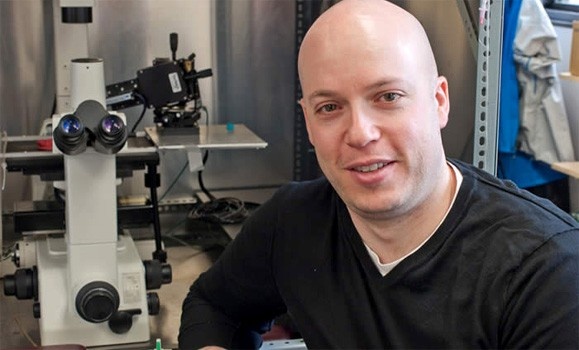The Heart and Stroke Foundation recently announced a national strategy to improve heart disease and stroke research in Canada: the . The foundation’s goal is to reduce Canadians’ rate of death from heart disease and stroke by 25 per cent by 2020.
A 10-year, $300 million funding commitment from the Heart and Stroke Foundation to Canada‚Äôs top institutions and researchers, the Research Leadership Circle represents the largest funding commitment in the Foundation‚Äôs history. The partnership includes 18 of Canada‚Äôs top research institutes, and AVæ„¿÷≤ø Medical School is the only research institute from Atlantic Canada.
Improving the cardiovascular health of Canadians
Dr. Robert Rose, assistant professor of physiology and biophysics at AVæ„¿÷≤ø and a Heart and Stroke Foundation-funded researcher, is taking part in the foundation‚Äôs quest. For Dr. Rose, the Research Leadership Circle ensures continued progress against what he calls a major health problem.
“This announcement means everything for my research, as well as the research of other Canadian scientists who are supported by the Heart and Stroke Foundation,” said Dr. Rose. “Continuing to support research is a primary and essential way to ensure the fight against cardiovascular disease is maintained at the highest possible level.”
The Research Leadership Circle will allow researchers like Dr. Rose to plan long-term studies in three main areas: preventing disease, saving lives and promoting recovery. Dr. Rose is currently studying the causes of cardiac arrhythmias (irregular heart beats) that occur in association with high blood pressure, heart failure, and diabetes.
“One of our goals is to determine the role of a family of cardioprotective hormones called natriuretic peptides,” explains Dr. Rose. “These peptides control important functions of the heart, like whether electrical activity in the heart is normal or irregular, and can protect a specialized region of the heart called the sinoatrial node, the heart’s natural pacemaker.”
Dr. Rose is also studying a prominent and dangerous arrhythmia called atrial fibrillation. He has discovered how genetic mutations in the natriuretic peptide system predispose people to atrial fibrillation and, in turn, how normal forms of the natriuretic peptide protect against this arrhythmia.
“The ultimate goal,” said Dr. Rose, “is to use the knowledge my team has gained to design synthetic natriuretic peptides for the treatment of heart arrhythmias and heart disease.”
Impact to the research community
As heart disease and stroke continue to be a major problem in Canada and around the globe, commitments like the Heart and Stroke Foundation’s Research Leadership Circle will facilitate research and new treatment possibilities.
As Dr. Rose explains, it can take up to 10 years for newly identified therapeutic possibilities to enter the clinical realm. It's essential that researchers guiding heart disease and stroke research are able to work with their knowledge, that long-term support is available, and that they are able to pursue research projects that require lengthy timeframes.
“A commitment such as this one will ultimately lead to new treatment options for people affected by cardiovascular disease.”
Dr. Gerry Johnston, associate dean of research at AVæ„¿÷≤ø Medical School, sees the Foundation‚Äôs promise having great impact on Canada‚Äôs research community.
“Heart disease and stroke researchers who pass peer review will have assured access to funding,” said Dr. Johnston. “This means that necessary infrastructure of a research program, including personnel, will not be lost, and researchers can plan ambitious and long-term studies.”
Dr. Johnston adds that this initiative will make AVæ„¿÷≤ø an attractive destination for new recruits to the area of heart disease and stroke research.
‚ÄúAVæ„¿÷≤ø‚Äôs inclusion in the Foundation‚Äôs Research Leadership Circle is recognition of the impact that AVæ„¿÷≤ø research will have on the health and well-being of Canada‚Äôs population,‚Äù said Dr. Johnston. ‚ÄúOver the next 10 years, this initiative can only enhance our capacity to make a difference in the health of our communities.‚Äù

